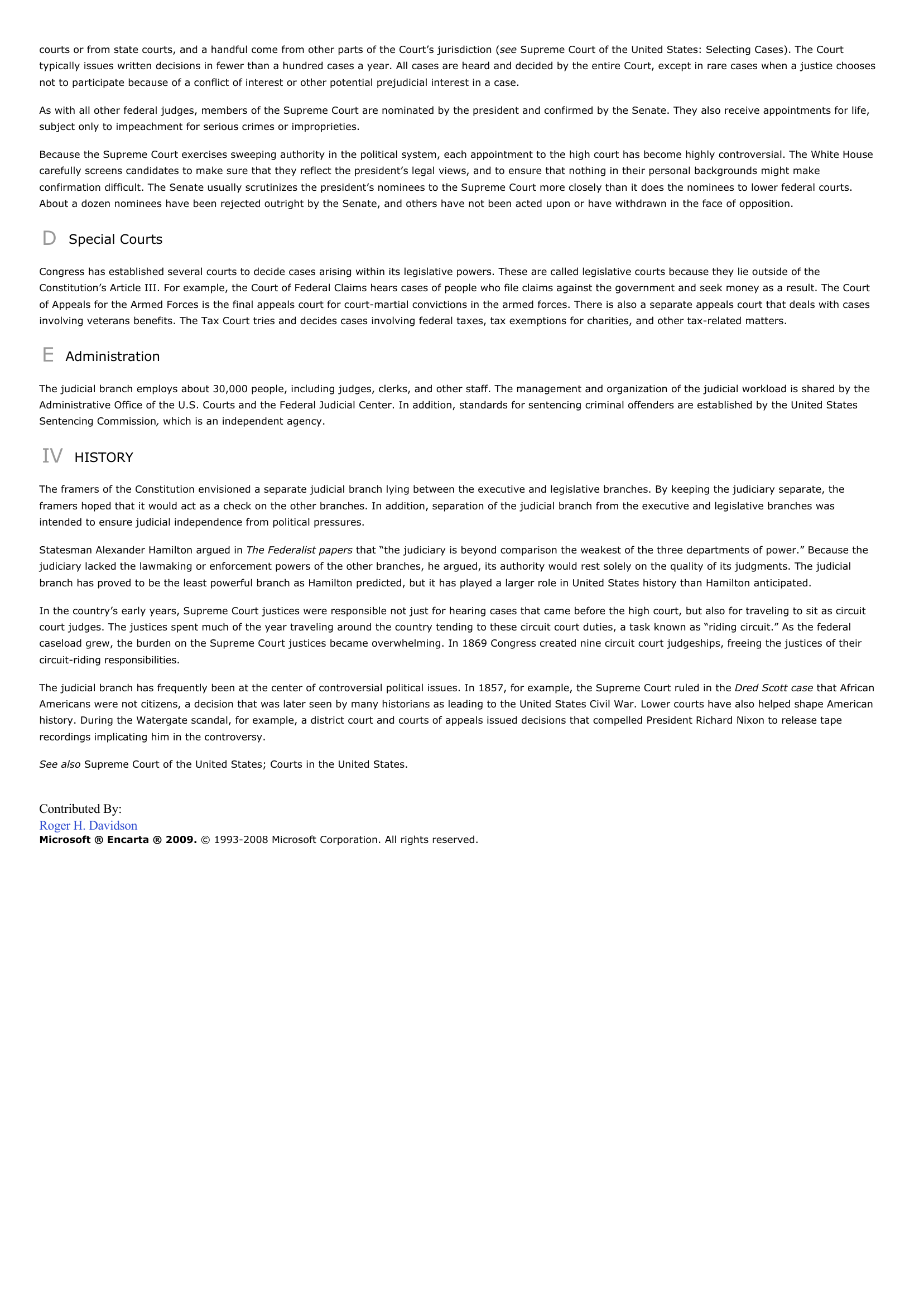Judicial Branch.
Publié le 10/05/2013
Extrait du document
«
courts or from state courts, and a handful come from other parts of the Court’s jurisdiction ( see Supreme Court of the United States: Selecting Cases).
The Court typically issues written decisions in fewer than a hundred cases a year.
All cases are heard and decided by the entire Court, except in rare cases when a justice choosesnot to participate because of a conflict of interest or other potential prejudicial interest in a case.
As with all other federal judges, members of the Supreme Court are nominated by the president and confirmed by the Senate.
They also receive appointments for life,subject only to impeachment for serious crimes or improprieties.
Because the Supreme Court exercises sweeping authority in the political system, each appointment to the high court has become highly controversial.
The White Housecarefully screens candidates to make sure that they reflect the president’s legal views, and to ensure that nothing in their personal backgrounds might makeconfirmation difficult.
The Senate usually scrutinizes the president’s nominees to the Supreme Court more closely than it does the nominees to lower federal courts.About a dozen nominees have been rejected outright by the Senate, and others have not been acted upon or have withdrawn in the face of opposition.
D Special Courts
Congress has established several courts to decide cases arising within its legislative powers.
These are called legislative courts because they lie outside of theConstitution’s Article III.
For example, the Court of Federal Claims hears cases of people who file claims against the government and seek money as a result.
The Courtof Appeals for the Armed Forces is the final appeals court for court-martial convictions in the armed forces.
There is also a separate appeals court that deals with casesinvolving veterans benefits.
The Tax Court tries and decides cases involving federal taxes, tax exemptions for charities, and other tax-related matters.
E Administration
The judicial branch employs about 30,000 people, including judges, clerks, and other staff.
The management and organization of the judicial workload is shared by theAdministrative Office of the U.S.
Courts and the Federal Judicial Center.
In addition, standards for sentencing criminal offenders are established by the United StatesSentencing Commission , which is an independent agency.
IV HISTORY
The framers of the Constitution envisioned a separate judicial branch lying between the executive and legislative branches.
By keeping the judiciary separate, theframers hoped that it would act as a check on the other branches.
In addition, separation of the judicial branch from the executive and legislative branches wasintended to ensure judicial independence from political pressures.
Statesman Alexander Hamilton argued in The Federalist papers that “the judiciary is beyond comparison the weakest of the three departments of power.” Because the judiciary lacked the lawmaking or enforcement powers of the other branches, he argued, its authority would rest solely on the quality of its judgments.
The judicialbranch has proved to be the least powerful branch as Hamilton predicted, but it has played a larger role in United States history than Hamilton anticipated.
In the country’s early years, Supreme Court justices were responsible not just for hearing cases that came before the high court, but also for traveling to sit as circuitcourt judges.
The justices spent much of the year traveling around the country tending to these circuit court duties, a task known as “riding circuit.” As the federalcaseload grew, the burden on the Supreme Court justices became overwhelming.
In 1869 Congress created nine circuit court judgeships, freeing the justices of theircircuit-riding responsibilities.
The judicial branch has frequently been at the center of controversial political issues.
In 1857, for example, the Supreme Court ruled in the Dred Scott case that African Americans were not citizens, a decision that was later seen by many historians as leading to the United States Civil War.
Lower courts have also helped shape Americanhistory.
During the Watergate scandal, for example, a district court and courts of appeals issued decisions that compelled President Richard Nixon to release taperecordings implicating him in the controversy.
See also Supreme Court of the United States; Courts in the United States.
Contributed By:Roger H.
DavidsonMicrosoft ® Encarta ® 2009. © 1993-2008 Microsoft Corporation.
All rights reserved..
»
↓↓↓ APERÇU DU DOCUMENT ↓↓↓
Liens utiles
- JURGEN James Branch Cabell (résumé)
- Katchen Julius , 1926-1969, né à Long Branch (New Jersey), pianiste américain.
- Cohen Paul Joseph, né en 1934 à Long Branch, mathématicien américain.
- Statistics I INTRODUCTION Statistics, branch of mathematics that deals with the collection, organization, and analysis of numerical data and with such problems as experiment design and decision making.
- Algebra I INTRODUCTION Algebra, branch of mathematics in which symbols (usually letters) represent unknown numbers in mathematical equations.

































